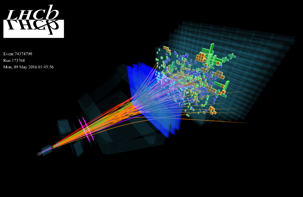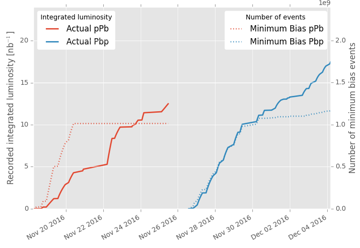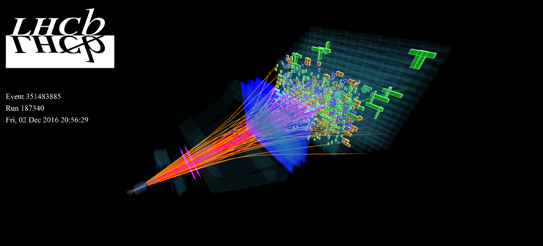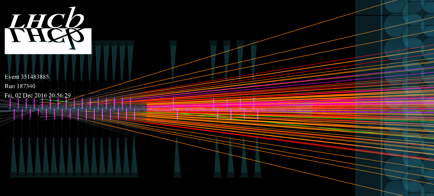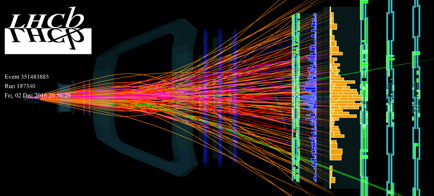The 2016 data taking period ended this morning. This was a very successful year, both because of the excellent performance of the accelerator and of the LHCb experiment itself.
The left and central images below show the growth in integrated luminosity during different years of LHC operation. Integrated luminosity is a measure of the number of proton-proton collisions produced by the accelerator. The increase of integrated luminosity with time in 2016 was similar to that in 2012; the period of data taking was, however, shorter. This excellent performance is mainly due to the higher efficiency of the accelerator this year. LHCb has recorded 1.67 fb-1 of proton-proton collisions this year, 5 times more than in 2015, a year in which LHC collider was setting-up its operation at the record energy of 13 TeV. The total integrated luminosity recorded during run 2 reached now the target of 2 fb-1 compared to 3 fb-1 collected in run 1.
The number of collected events per unit time for a given physics process, N, is proportional to the instantaneous luminosity, L, which is a measure of the brightness of the colliding beams, and to the characteristic property of interaction, cross-section, σ; N=σL. The cross-section for b- and b-quark production at 13 TeV proton-proton collision is about twice that of run 1 (see 5 August 2016 news, item (1)). Since the integrated luminosity is merely the instantaneous luminosity added up over the time the accelerator is operating, the 2 fb-1 Run 2 data sample contains a larger number of beauty particle decays than the 3 fb -1 Run 1 data sample. The increase of number of recorded charmed particles per unit of integrated luminosity was even higher, by a factor of 5, both due to the higher cross-section at 13 TeV and to improvements in the event selection (so-called “trigger”) during data taking. This is excellent news for future LHCb physics analyses. The right image above shows a typical proton-proton collision event.
The proton collisions with lead ions took place during last three weeks of data taking period. The left image above shows the increase of integrated luminosity as a fuction of time depending in which LHC ring protons and lead (Pb) ions are located; the first one (p or Pb) indicates which beam is pointed towards the one-sided LHCb detector. In total 31 nb-1 were recorded. The right image above shows a typical high multiplicity proton-lead-ion collision event, the left one below shows a zoom around the collision vertex and the right one below shows the event as seen from above. Particles identified as pions (orange), kaons (red), protons (magenta), electrons (blue) or muons (green) are shown in different colours. In addition to collected p-lead collisions, LHCb collected data from proton-helium interactions at the same time. This was achieving by injecting helium gas as a target directly in the region of the LHCb Vertex Locator (VELO), and recording those occasions when the circulating protons hit these near-stationary helium nuclei. Such a mode of operation is called “fixed target” data taking and at the LHC is unique to LHCb.
A traditional end of the year shutdown period starts now. It is used for maintenance and improvements of the LHC and its detectors. This time it will be longer due to major installation work carried-out in one the LHC detectors. Therefore the name of “Extended Year End Technical Stop”, EYETS, has been given to this shutdown period. LHCb plans for this period include some relatively minor maintenance work on the detector, together with more major interventions on the access lift and the crane in the underground cavern. It is planned that protons will start to circulate again in the LHC at the beginning of May and that the first proton-proton collisions for physics will take place in mid of June.
Click the images for higher resolution.



